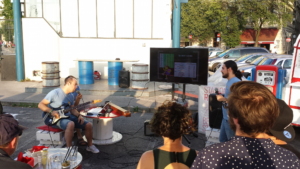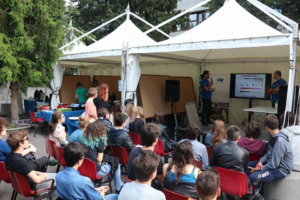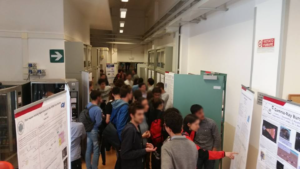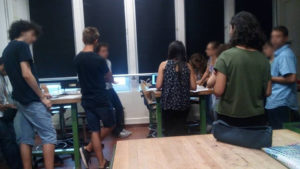 Besides the various big science events that take place in Trieste, we believe it is important to bring
Besides the various big science events that take place in Trieste, we believe it is important to bring
scientific dissemination to the general public also in its every day life. For this reason, we like to
organize events in pubs, to talk about science in a relaxed setting. Last summer, we had a talk
entitled “Sounds right? Sounds good!” about the physics of music at a pub, just before a local band
played some good music. With the help of a guitar and a string, we talked about how music is
described by waves, what spectral range we humans are able to hear and what the role of
harmonics is in the characteristics of the various music instruments.
Mini Maker Faire – Science Picnic
 Trieste has a very high concentration of research centres. This results in various big scientific events,
Trieste has a very high concentration of research centres. This results in various big scientific events,
which gather people from the institutes and university to present their activity to the general
public. Among these events there are the Mini Maker Faire and the Science Picnic, which in 2016
took place consecutively at the International Centre for Theoretical Physics, in which we took part
with our own stand. There, we presented to the public facts about space science and the Solar
System. We had 3D-printed models of comet 67P/Churyumov-Gerasimenko and of the ESA Rosetta
probe, paper models of the Rosetta probe to give out to kids, posters on the Solar System and a
binocular, which projected on a cardboard the Sun and a solar spot.
Besides our stand, we had many time-slots to present our talks on the physics of music (“Sounds
right? Sounds good!”), the ESA Rosetta mission, the measurement of the cosmic microwave
background, and the observation of the sky in the infrared spectral range from the Antartic and
from space. In more detail, the measurement of the CMB was discussed with the aid of guitar, to
present it in analogy to the description of waves on a string. The talk on the observation of the
infrared sky was, instead, in the form of a double talk with two speakers, each arguing in favour of
his preferred kind of location.
The number of people reached in these events is large, since these attract people both from the city
and from the whole Friuli-Venezia Giulia region. The total number of visitors to the Mini Maker Faire
has been estimated by the organizers to be 18000. Given its success, we will participate also in the
2017 edition.
Poster session at the Physics Department
 One of the goals of the Young Minds Project is to foster the networking among young researchers
One of the goals of the Young Minds Project is to foster the networking among young researchers
and students. As our first activity, we organized a spring poster session for the master and PhD
students of the Physics Department of the University of Trieste. The poster session took place in
the corridors of the Physics Department on the two days of the presentation to the students of the
Master Course in Physics and during the following week. The posters had, therefore, a high visibility
due both to the high number of people present for the Master Course presentation and to their
location in the core place of the Department’s life.
The posters numbered 16 and were presented by master and PhD students. Among the topics
covered we had high-energy astrophysics, quantum information, chemical evolution of galaxies,
out-of-equilibrium condensed matter, space and satellites physics, density functional theory
calculations, and stabilization of laser cavities. For the PhD students, the poster session has been
very useful to present their work to fellow PhD students and possible bachelor and master students
coming to their labs and groups for their internships or theses. To the master students, it provided
the opportunity to present for the first time their thesis work, a few months before the final
graduation defense.
In addition to the presenting students and to the audience, the activity was welcomed also by the
Professors, who encouraged their students to present a poster on their work. Given the success of
the activity, it will be repeated in late spring 2017.
Waves in physics and beyond
 The recurrence in Trieste activities of the role of waves in physics motivated us to develop a more in-depth activity on waves. For this reason, we asked the Young Minds Project to finance the building of an educational model of spectrometer. Such spectrometer fits in a larger educational/outreach unit, in which we present to students and the general public the spectral analysis of waves.
The recurrence in Trieste activities of the role of waves in physics motivated us to develop a more in-depth activity on waves. For this reason, we asked the Young Minds Project to finance the building of an educational model of spectrometer. Such spectrometer fits in a larger educational/outreach unit, in which we present to students and the general public the spectral analysis of waves.
The concept of spectrum and of Fourier analysis is first introduced with a well-known object, the tuning fork. With the aid of a smartphone app, it is possible to show various aspects of sound waves, like the origin of harmonics and the spectrum of the human voice.
After the introduction of the concepts via sound waves, the spectral analysis of light allows to introduce more advanced concepts. A spectrometer allows, in fact, to see that not all light that appears as white is the same. Light from a light bulb, from a smartphone flashlight, or from discharge lamps can be shown to be different, introducing the concept of quantized energy levels in the atoms, in analogy with the discrete spectrum of a tuning fork.
This outreach unit was used for the first time in the context of a week-long college fair for 32 high school students visiting the Physics Department. In that occasion, we could use a spectrometer borrowed from a laboratory, to show the students how the spectra from the various sources look like. Afterwards, the students measured the spectrum of mercury with the home-built educational spectrometer, which is composed by a prism and a photodiode on a mechanical translator. Such rudimentary spectrometer is very useful from an educational point of view, since it allows the students to identify the key aspects in the measurement of a spectrum, such as a collimated incoming light beam and darkness in the lab. During the activity, the students were asked to answer a set of questions.
On the basis of our simple spectrometer, we are now supervising a high school student in her final-year project, for which she is building a more advanced educational spectrometer, whose draft layout is reported in the picture. This consists of a diffraction grating obtained from a DVD and a webcam sensor. While this spectrometer will be a closed-box instrument and will not be a hands-on object like the one described above, it allows to rapidly measure spectra. In the context of this student’s project, it will be used to measure the spectrum of differently coloured leaves.
We are also setting up a collaboration with a school in our region to prepare an experimental educational unit for high school students on thermal radiation and on the quantization of the atomic energy levels. Our estimate is that this will make us indirectly reach 40 students per year, since the class will be repeated every school year.
Finally, we are designing an object to illustrate the phenomenon of diffraction by a lattice. In particular, a lattice made of air balloons can produce a sound-waves diffraction pattern, in which people can literally walk.
